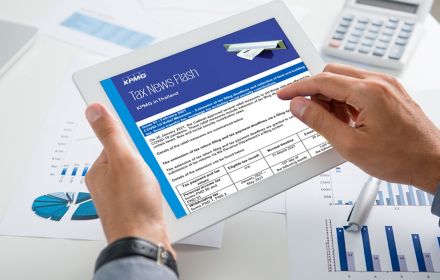Introduction
Following KPMG Thailand’s Tax News Flash Issue 137 on Thailand’s official plan on the OECD’s BEPS 2.0 Pillar 2 (Global Minimum Tax), the Board of Investment (BOI) in Thailand publicly released a new BOI notification (No. 1/2566) on its website in May 2023. This new BOI notification concerns the impact of Thailand’s tax holiday as it is aimed to alleviate the Top-up Tax impact on taxpayers that are in the Pillar 2 scope.
Background
BOI notification No. 1/2566 was statutorily issued with effect from 20 March 2023 but was announced by the Prime Minister on 16 May 2023. The contents of the notification have been provided to Thai BOI promoted companies identified as being generally in the scope of Pillar 2, i.e., those within multinational enterprise groups that meet the consolidated group revenue of not less than THB 28 billion (c. EUR 750 million) and have been subject to Country-by-Country Reporting (CbCR) requirements.
New measure – Election to apply a 10 percent corporate income tax rate
This BOI notification allows for qualified BOI promoted companies currently enjoying BOI income tax exemption incentives in Thailand to elect applying 50 percent of the statutory corporate income tax (CIT) rate at 20 percent, thereby applying a 10 percent CIT rate for the remaining tax exemption period. By electing a 10 percent CIT rate in lieu of income tax exemption, the taxpayer’s tax incentive period will be doubled by the remaining tax exemption period. The adopted 10 percent CIT rate is limited to a maximum of ten years, which includes the five years already granted to some taxpayers holding a BOI incentive allowing a five-year 50 percent CIT rate reduction after the expiration of the tax exemption period. This election also applies in a similar manner to new BOI investment promoted projects for qualified BOI promoted companies in Thailand.
The way the election is applied can be illustrated in the following examples.
Example 1: Company A is entitled to BOI tax incentives that include a tax exemption (0 percent CIT) for eight years (0 percent CIT), and a reduced CIT rate (10 percent CIT) for five years, after the end of the tax exemption period. If Company A’s remaining tax exemption period is three years, Company A can elect applying 10 percent CIT for an aggregate period of ten years.
Example 2: Company B is entitled to the same BOI tax incentives, but the remaining tax holiday period is two years. Company B can elect to applying 10 percent CIT for an aggregate period of nine years.
Important points
The election can be applied to existing investors as well as new investors that are generally in the Pillar 2 scope in addition to meeting certain specific criteria and conditions (hence, becoming qualified BOI promoted companies). These criteria and conditions should be carefully considered in the context of each taxpayer’s individual facts and circumstances in discussion with the BOI. According to the new BOI notification, once the application is approved by the BOI, the taxpayer would need to confirm its acceptance of the approved incentive within one month. The notification also indicates that, once accepted, the taxpayer cannot make any further amendments.
Key observations
The new BOI notification puts Thailand at the incentives front with other jurisdictions that are understood to be normalizing 10 percent as the incentive rate, with the following advantages.
- Besides the Global Anti-Base Erosion (GloBE) Rules that are part of the Pillar 2 rules and set out how multinational groups must calculate the Effective Tax Rate (ETR) on a jurisdictional blending basis, Pillar 2 rules also include the Subject-to-Tax Rule (STTR), which operates by way of imposing top-up withholding tax on covered payments in cross-border situations where the ETR on such covered payments appears to be lower than 9 percent. The 10 percent CIT rate has the advantage of being above the 9 percent STTR threshold.
- Where BOI promoted companies in Thailand are given the option of a 10 percent CIT rate, likelihood of multinational groups to have less Top-up Tax because of Thai companies would arise as they could keep a jurisdictional blended CIT rate for Thailand close to the OECD’s global minimum rate of 15 percent. This likelihood would be heightened if multinational groups can access the Substance Based Income Exclusion (SBIE), which considers the level of payroll costs and tangible assets in Thailand, and Thai companies are part of the same group for jurisdictional blended ETR calculation purposes.
Multinational groups that will be impacted by the forthcoming BEPS 2.0 Pillar 2 legislation in Thailand and other jurisdictions should assess whether they have companies in Thailand that can make the election under the new BOI measure. The key question is to determine if it is worth making the election against the backdrop of the broader Top-up Tax impact assessment. Such determination may, in certain cases, require a scenario analysis involving a complete understanding of Thai companies in the scope – including their rationale of continuing to enjoy (or getting new) BOI tax incentives in Thailand – as well as identification of their respective status under Pillar 2 rules whether they are required to perform ETR calculations separate from other companies in Thailand on a jurisdictional blending basis.
For Thai companies with existing BOI tax incentives and having had revenues from the operation of BOI promoted activities already, the adopted 10 percent CIT rate (if elected) would take effect from the date of the first revenue generated after receiving a new BOI certificate, after which any CIT related rights and privileges granted under the original BOI certificate should cease to exist. The notification does not in itself provide further guidance on the extent and scope of this cessation. Which rights and privileges under the original BOI certificate that would remain after the election is made is a matter that should be clarified with the BOI.
If you would like to discuss the topics above or BEPS 2.0, please contact the BEPS team at KPMG in Thailand.
Key contacts
Connect with us
- Find office locations kpmg.findOfficeLocations
- kpmg.emailUs
- Social media @ KPMG kpmg.socialMedia



